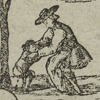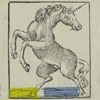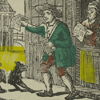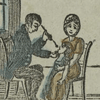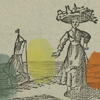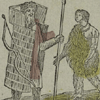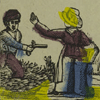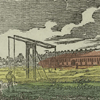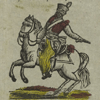Catchpenny prints of the Koninklijke Bibliotheek > Catchpenny prints in detail
't Leeven en Bedrijf van Jan de Wasser met zijn wijf [the Life and Career of Jan de Wasser and his wife]
In this print of the household of Jan de Wasser, the proverbial henpecked husband, the world is turned upside down. His wife Griet orders him to do all the domestic work, to lie in the childbed and to look after the child. Of this popular comic strip many versions were made, always adapted to changing times. This eighteenth-century version of the story shows how they are sailing to the Volewijk, the gallows field across the river IJ in Amsterdam. This is not just a jolly trip, because this is the place where babies come from! The state of hygiene in those days can be seen in a woodcut showing Jan letting his little child shit.
Kluchtige gestalten en dieren = Scènes grotesques [Comical figures and animals]
Catchpenny prints by no means always contain a story. They can also be a mixture of separate illustrations, sometimes thematically arranged featuring for instance animals or trades. According to the title this print shows ‘comical figures and animals’, among which are counted both mythological figures such as Bacchus, and apes very much resembling humans, clowns and showmen. The puking drunkard has perhaps also been to the fun fair. A unicorn fits exactly within the frame-line of this woodcut. This is an indication that a talented craftsman has been at work: Alexander Cranendoncq.
Onderscheidene bedrijven = Differents métiers [Various trades]
A catchpenny print showing vendors of various wares: everyone plies only one kind of trade. Pots and pans, matchsticks, clocks, fur, peat, lace and ribbons and little birds. Foods such as cherries, onions and eggs: all is sold in the street and delivered at the door. Newspapers too, are being hawked as can be seen here. The odd thing is that in the text the Moorenland [land of the Moors] is in French Mexique. These are detailed illustrations, in which the town and its doings and dealings are displayed. At the bottom of this print a totally different series of four woodcuts is included. This shows how the separate woodblocks were used again and again in many different ways.
Vooraf gedaan, daarna bedacht, heeft menigëen in leed gebragt [Acting before thinking has brought many to distress]
A mother with a painful expression on her face is holding her daughter, while the doctor tries to remove a swallowed needle from the child. The other children in this catchpenny print, which is undoubtedly meant as a warning, do not at all fare well either. They fall from coaches, from boats and windows, from swings, stairs and ladders, they get scratches, scoldings, kicks and beatings, and fall through the ice; and it’s all their own fault! But the question remains whether children became obedient and careful by means of such a print.
O hoe edel is het kind, dat tot deugden is gezind! [O how noble is the child that is inclined to virtues!]
Some catchpenny prints are intended to contribute to the upbringing of children. In the present case the printmaker presents a number of virtuous children as an example. They give alms, take care of the sick and look after housekeeping, stem bleeding wounds, assist blind people, rescue drowning persons and save money to buy a book. In one of the woodcuts is shown how a boy rescues a baby from a house on fire and returns it to the desperate mother. A dramatic event that has been accurately represented.
Een landman ziet den avondtijd [A countryman watches the evening hour]
There are quite a lot of catchpenny prints showing various trades and professions. Here the daily work of farmer, shepherd, milkmaid, gardener and butcher can be seen. A cripple– apparently disability was also regarded as a profession – does not wait for an alms, but looks with longing eyes at the linen on the bleaching green. An elegantly cut Scheveningen woman fish seller carries her trade on her head. The three colours in this specimen have been nonchalantly applied with dabbers. At the bottom of this print, which was printed by Jan de Lange in Deventer, the name J.J. Bollemij is recorded with his address. It was common practice to print the name of a printer or seller, who bought a large quantity of prints, onto the print. In his handbook De volks- en kinderprent in de Nederlanden van de 15e tot de 20e eeuw Maurits de Meyer has recorded who the real publishers are, and who are the ‘retailers’.
Land-beschryf-kundig Nieuw-jaar of zeden en gewoonten van de voornaamste volken der wereld [Geographical New Year present or customs and traditions of the principal peoples of the World]
Centuries ago traveling to distant countries was only reserved for sailors and explorers. How then could ordinary people become acquainted with other inhabitants of the earth? At fun fairs images of other peoples were shown in the peepshow box. But catchpenny prints too, met the need for information about other nationalities. They were not always equally truthfully represented, but generally in a colourful way indeed, as can be seen in this print. The appearance and qualities of other peoples were thus recorded and passed on.
Laet lieve kinderen, laet, de moordlust en bedryven = Laissez braves enfans, entre dans vos memoires [Dear children, do not engage in murderous acts]
Crime stories have always been popular. Cartouche was a notorious rascal, whose life story has been represented in various prints. Already as a child he is good for nothing; beating and house of correction don’t make him any the more obedient. Things go from bad to worse, robberies, hold-ups, the forgery of bills of exchange, and even murder. He is reckless enough to disguise himself as a priest or a general to play his dirty tricks. But he is caught and ends on the gallows.
Nederlandsche weldadigheid [Dutch charity]
Instructive prints come on the market especially after 1800, under the influence of the Society for Public Welfare. The subjects include national heroes, nature, seasons, farming, fishing and foreign countries. This print shows what kinds of charitable works were organized at the beginning of the nineteenth century. This ranged from free smallpox vaccination to shelter for the sick, orphans, disabled and elderly people. The Veenhuizen reeducation colony for the poor and homeless is also portrayed.
O wat groote dapperheid! = Un Russe animé de courage [O what great courage]
Warfare is a popular subject in catchpenny prints from the Southern Netherlands. Usually it concerns accounts of heroic soldiers – Van Speijk figures prominently in the national prints – but the downside is also shown occasionally. This print shows which soldiers wrought havoc in Europe, for instance: Russians, Mamelukes, Cossacks and Prussians are involved. War as such is here described as ‘a scourge of the earth’. Robbing killed soldiers, threatening women and stealing from citizens are apparently part and parcel of the conduct of war.

